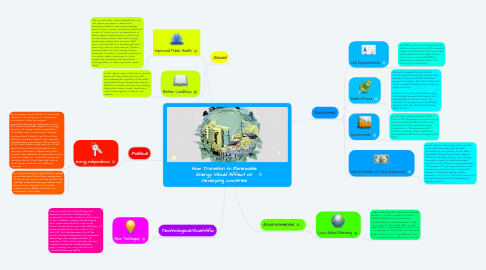
1. Social
1.1. Improved Public Health
1.1.1. The air and water pollution emitted by coal and natural gas plants is linked with breathing problems, neurological damage, heart attacks, cancer, premature death, and a host of other serious problems.Most of these negative health impacts come from air and water pollution that clean energy technologies simply don’t produce. Wind, solar, and hydroelectric systems generate electricity with no associated air pollution emissions.Wind and solar energy require essentially no water to operate and thus do not pollute water resources or strain supplies by competing with agriculture, drinking water, or other important water needs.
1.2. Better Conditions
1.2.1. In India, where many people live in remote areas off the power grid, the GEF strengthened the capacity of the Indian Renewable Energy Development Agency (IREDA) to develop off-grid solar energy. Among the results: longer study hours, under better lighting conditions, for children.
2. Political
2.1. energy independence
2.1.1. By increasing the proportion of renewable sources in its energy mix for electricity consumption, China can mitigate geopolitical tensions by making the country less reliant on unstable regions for energy security. An energy market dependent on fossil fuels relies on securing oil and gas transportation routes to and from fossil fuel-rich countries, which in turn requires extended military protection. The protection of oil transit choke points was one of the reasons why China constructed its first overseas naval base in Djibouti last year.In contrast, the availability of resources such as wind and sunlight for renewable energy far outstrips that of fossil fuels and is much more evenly spread across different countries.
2.1.2. as renewable energy usage diffuses globally as an externality from China’s development of the sector, more countries will have the potential to become energy producers and hence be less dependent on unstable regions such as MENA and Russia for conventional fossil fuels.
3. Technological/Sceintific
3.1. New Techlogies
3.1.1. China has been narrowing the gap with western countries in developing key components of solar panels in recent years. Trina, a Chinese company and the largest solar panel manufacturer in the world, broke the world record on the efficiency of multicrystalline-silicon solar cells in 2014 and 2015. As China becomes one of the world’s foremost developers of renewable technology, the strategic benefits of investing in China and cooperating with the Chinese in research and development might outweigh the costs and risks of potential technology thefts.
4. Economic
4.1. Job Opportinities
4.1.1. The 2009 Union of Concerned Scientists study of a 25-percent-by-2025 renewable energy standard found that such a policy would create more than three times as many jobs (more than 200,000) as producing an equivalent amount of electricity from fossil fuels
4.2. Stable Prices
4.2.1. Although renewable facilities require upfront investments to build, they can then operate at very low cost (for most clean energy technologies, the “fuel” is free). As a result, renewable energy prices can be very stable over time. Moreover, the costs of renewable energy technologies have declined steadily, and are projected to drop even more. For example, the average price to install solar dropped more than 70 percent between 2010 and 2017
4.3. Investments
4.3.1. the GEF has invested more than US$1.1 billion in 249 stand-alone renewable energy projects, as well as US$277 million in 54 mixed projects with renewable energy components, in 160 developing and transition countries. These investments have attracted additional investment of $14 billion
4.4. improvements of local businesses
4.4.1. In India, where many people live in remote areas off the power grid, the GEF strengthened the capacity of the Indian Renewable Energy Development Agency (IREDA) to develop off-grid solar energy. Among the results: a five-fold income increase among farmers using photovoltaic (PV) pumps; a 50 percent increase in net income among some traders using solar instead of kerosene lighting; income increases of 15 to 30 percent in some rural households because of increased home industry output;
5. Environmental
5.1. Less Global Warming
5.1.1. urning natural gas for electricity releases between 0.6 and 2 pounds of carbon dioxide equivalent per kilowatt-hour (CO2E/kWh); coal emits between 1.4 and 3.6 pounds of CO2E/kWh. Wind, on the other hand, is responsible for only 0.02 to 0.04 pounds of CO2E/kWh on a life-cycle basis; solar 0.07 to 0.2; geothermal 0.1 to 0.2; and hydroelectric between 0.1 and 0.5.

